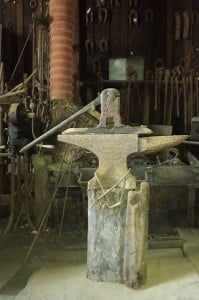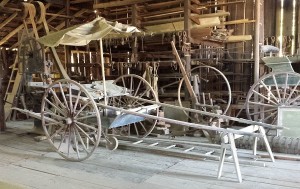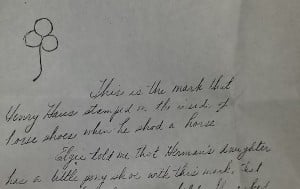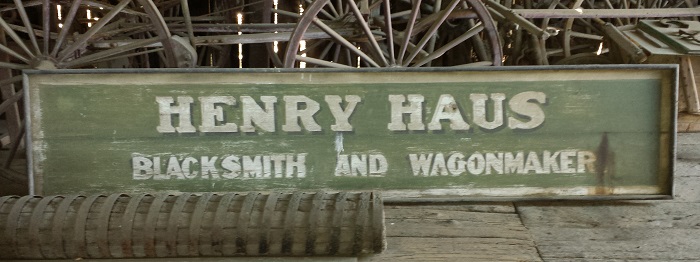Pope Valley
Henry Haus Blacksmith and Wagonmaker Shop
by John Holt
Long before there was a garage or service station on nearly every corner to keep modern fine-tuned vehicles and machinery in proper working order, the transportation go-to place was the blacksmith shop. Vital to that earlier distribution and transportation economy, the blacksmith shop played a key role in the western expansion and settlement of the our country. Most every wagon train heading for the new territories strove to have the blacksmith skills among its entourage not only for the trip west but to sustain the community once settled.
 Every blacksmith needed a hammer, anvil, and forge with bellows. Those basic tools for the working of iron and metal had to be sturdy and, for wagon trains and military units, also portable. Careful attention was paid to design and weight as most portable anvils were fifty pounds or less; the lightest workable anvil was listed at fourteen pounds.
Every blacksmith needed a hammer, anvil, and forge with bellows. Those basic tools for the working of iron and metal had to be sturdy and, for wagon trains and military units, also portable. Careful attention was paid to design and weight as most portable anvils were fifty pounds or less; the lightest workable anvil was listed at fourteen pounds.
Wooden wheels with metal rims needed careful attention and frequent repair to keep them turning. The blacksmith shop was the natural location for fabricating and repairing these essential items of locomotion. Key to getting the metal rims on a wooden spoke wheel was a tool called the traveler – an eight inch diameter wheel used to roll around the outside of a wooden wagon wheel and inside the metal rim to determine the circumference in order to make the rim the right size. Nineteenth century traveler tools were usually cast iron with pointers attached to keep count of the number of revolutions – Henry Haus’ traveler still hangs on the back wall of his blacksmith shop.
 The Henry Haus Blacksmith and Wagonmaker Shop today remains in nearly the same exact configuration it was over a hundred years ago. One can still find most of the blacksmith’s tools and the old “half-hooded forge” Henry used while servicing the inhabitants of Pope Valley. There are travelers, swages, flatters, hammer creases, and Henry’s shearing machine, as well as many local horseshoes and branding irons, a handmade buggy built by Ed Haus, a foot pedal and hand operated “bottler/corker” used in valley wineries, and a 100-year-old wheelbarrow with its original wood spoke wheel.
The Henry Haus Blacksmith and Wagonmaker Shop today remains in nearly the same exact configuration it was over a hundred years ago. One can still find most of the blacksmith’s tools and the old “half-hooded forge” Henry used while servicing the inhabitants of Pope Valley. There are travelers, swages, flatters, hammer creases, and Henry’s shearing machine, as well as many local horseshoes and branding irons, a handmade buggy built by Ed Haus, a foot pedal and hand operated “bottler/corker” used in valley wineries, and a 100-year-old wheelbarrow with its original wood spoke wheel.
There is a piece of what is thought to be the original water pipe Henry made and his business sign that hung proudly on the front of the shop for over eight decades until in the early eighties when it was stolen. Local residents offered a reward and it was quickly recovered. Since replaced on the front of the shop, the first sign now safely resides inside only for display during open houses.
 One historic item that most probably will not be seen at the shop is Henry’s “mark” he stamped on the inside of the shoes of every horse he shod, just as most blacksmiths and farriers did. Henry used a mark stamp shaped like a 3-leaf clover with a long stem bent to the left at its end. In 1994 Herman Haus’ daughter (in possession of a pony shoe that Grandpa Henry had given her as a child with his mark inside), asked the Historical Society if they had seen the “mark” stamp. A thorough search did not disclose its location until an old Pope Valley horseshoer, familiar with the shop, came by and quickly found it. Rather than put it on display, it was thought Henry and Herman would have liked to keep it in its hidden location. It’s there today, wherever that may be. Perhaps you can find it?
One historic item that most probably will not be seen at the shop is Henry’s “mark” he stamped on the inside of the shoes of every horse he shod, just as most blacksmiths and farriers did. Henry used a mark stamp shaped like a 3-leaf clover with a long stem bent to the left at its end. In 1994 Herman Haus’ daughter (in possession of a pony shoe that Grandpa Henry had given her as a child with his mark inside), asked the Historical Society if they had seen the “mark” stamp. A thorough search did not disclose its location until an old Pope Valley horseshoer, familiar with the shop, came by and quickly found it. Rather than put it on display, it was thought Henry and Herman would have liked to keep it in its hidden location. It’s there today, wherever that may be. Perhaps you can find it?
This post is the first of a two-part series highlighting the Haus Blacksmith Shop in Pope Valley. The series is part of the 2016 Napa Valley History Tour.
Bibliography
Herman Haus grant deed (AO No. 18-100-05) recorded 12/31/1984.
“A World of Tools in One Museum,” Anvil Magazine, Dec. 2001.
“Henry Haus Blacksmith & Wagonmaker,” Dan Grigsby, NCHS summary, 1978.
“Keeping Tradition in Napa Valley,” NV Register, 1/7/1972.
“Tools That Made Our World,” www.antiquetools.com, 1999 01 Inc. NYC.
“The Wheelwrights Shop,” George Sturt, Cambridge U. Press, 1923+.
“Pope Valley Blacksmith Shop Opens the on the Past,” NV Register, 4/24/2008.


